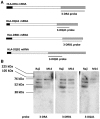EBP1 and DRBP76/NF90 binding proteins are included in the major histocompatibility complex class II RNA operon
- PMID: 21624892
- PMCID: PMC3167597
- DOI: 10.1093/nar/gkr278
EBP1 and DRBP76/NF90 binding proteins are included in the major histocompatibility complex class II RNA operon
Abstract
Major histocompatibility complex class II mRNAs encode heterodimeric proteins involved in the presentation of exogenous antigens during an immune response. Their 3'UTRs bind a protein complex in which we identified two factors: EBP1, an ErbB3 receptor-binding protein and DRBP76, a double-stranded RNA binding nuclear protein, also known as nuclear factor 90 (NF90). Both are well-characterized regulatory factors of several mRNA molecules processing. Using either EBP1 or DRBP76/NF90-specific knockdown experiments, we established that the two proteins play a role in regulating the expression of HLA-DRA, HLA-DRB1 and HLA-DQA1 mRNAs levels. Our study represents the first indication of the existence of a functional unit that includes different transcripts involved in the adaptive immune response. We propose that the concept of 'RNA operon' may be suitable for our system in which MHCII mRNAs are modulated via interaction of their 3'UTR with same proteins.
Figures







Similar articles
-
Co-regulated expression of alpha and beta mRNAs encoding HLA-DR surface heterodimers is mediated by the MHCII RNA operon.Nucleic Acids Res. 2013 Apr 1;41(6):3772-86. doi: 10.1093/nar/gkt059. Epub 2013 Feb 7. Nucleic Acids Res. 2013. PMID: 23393186 Free PMC article.
-
NF90 binds the dengue virus RNA 3' terminus and is a positive regulator of dengue virus replication.PLoS One. 2011 Feb 28;6(2):e16687. doi: 10.1371/journal.pone.0016687. PLoS One. 2011. PMID: 21386893 Free PMC article.
-
Double-stranded RNA-binding protein regulates vascular endothelial growth factor mRNA stability, translation, and breast cancer angiogenesis.Mol Cell Biol. 2008 Jan;28(2):772-83. doi: 10.1128/MCB.02078-06. Epub 2007 Nov 26. Mol Cell Biol. 2008. PMID: 18039850 Free PMC article.
-
The Polyvalent Role of NF90 in RNA Biology.Int J Mol Sci. 2022 Nov 5;23(21):13584. doi: 10.3390/ijms232113584. Int J Mol Sci. 2022. PMID: 36362366 Free PMC article. Review.
-
A PUF family portrait: 3'UTR regulation as a way of life.Trends Genet. 2002 Mar;18(3):150-7. doi: 10.1016/s0168-9525(01)02616-6. Trends Genet. 2002. PMID: 11858839 Review.
Cited by
-
ErbB3-binding protein EBP1 decreases ErbB2 levels via a transcriptional mechanism.Oncol Rep. 2013 Mar;29(3):1161-6. doi: 10.3892/or.2012.2186. Epub 2012 Dec 14. Oncol Rep. 2013. PMID: 23242156 Free PMC article.
-
HLA-DQA1 and HLA-DQB1 Alleles, Conferring Susceptibility to Celiac Disease and Type 1 Diabetes, are More Expressed Than Non-Predisposing Alleles and are Coordinately Regulated.Cells. 2019 Jul 19;8(7):751. doi: 10.3390/cells8070751. Cells. 2019. PMID: 31331105 Free PMC article.
-
ADP-Ribosylation Post-Translational Modification: An Overview with a Focus on RNA Biology and New Pharmacological Perspectives.Biomolecules. 2022 Mar 13;12(3):443. doi: 10.3390/biom12030443. Biomolecules. 2022. PMID: 35327636 Free PMC article. Review.
-
EBP1 protein modulates the expression of human MHC class II molecules in non-hematopoietic cancer cells.Int J Oncol. 2015 Aug;47(2):481-9. doi: 10.3892/ijo.2015.3051. Epub 2015 Jun 16. Int J Oncol. 2015. PMID: 26081906 Free PMC article.
-
Co-regulated expression of alpha and beta mRNAs encoding HLA-DR surface heterodimers is mediated by the MHCII RNA operon.Nucleic Acids Res. 2013 Apr 1;41(6):3772-86. doi: 10.1093/nar/gkt059. Epub 2013 Feb 7. Nucleic Acids Res. 2013. PMID: 23393186 Free PMC article.
References
-
- Cresswell P. Assembly, transport, and function of MHC class II molecules. Annu. Rev. Immunol. 1994;12:259–293. - PubMed
-
- Rodriguez T, Mendez R, Del Campo A, Aptsiauri N, Martin J, Orozco G, Pawelec G, Schadendorf D, Ruiz-Cabello F, Garrido F. Patterns of constitutive and IFN-gamma inducible expression of HLA class II molecules in human melanoma cell lines. Immunogenetics. 2007;59:123–133. - PubMed
-
- Guardiola J, Maffei A. Control of MHC class II gene expression in autoimmune, infectious, and neoplastic diseases. Crit. Rev. Immunol. 1993;13:247–268. - PubMed
-
- Reith W, LeibundGut-Landmann S, Waldburger JM. Regulation of MHC class II gene expression by the class II transactivator. Nat. Rev. Immunol. 2005;5:793–806. - PubMed
-
- Tite JP, Janeway CA., Jr Antigen-dependent selection of B lymphoma cells varying in Ia density by cloned antigen-specific L3T4a+ T cells: a possible in vitro model for B cell adaptive differentiation. J. Mol. Cell Immunol. 1984;1:253–265. - PubMed
Publication types
MeSH terms
Substances
LinkOut - more resources
Full Text Sources
Research Materials
Miscellaneous

